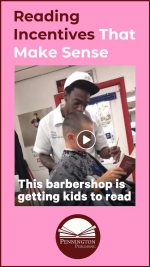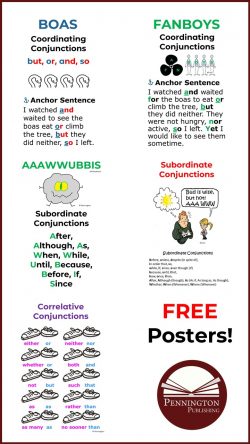Reading Incentive Ideas
I’m not active on Facebook, but my wife passed along this post, “This Barbershop is Getting Kids to Read.” Kids are encouraged to read out loud during their haircuts at this Pennsylvania barbershop “to help boost confidence and conquer fears of public speaking.” The incentive? Kids who read a line, page, or chapter (presumably based upon age and the discretion of the barber) are awarded $3.00 for their efforts.
As kids you don’t realize that fear can carry on as an adult. I want people to feel like they have a voice and they need to use it.
Jon Escueta, Owner City Cuts Barbershop as told to NOW THIS NEWS.
A smart marketing ploy? Undoubtedly. But also a terrific business partnership to develop with local schools. Escueta says he serves roughly 500 kids in his community.
As an M.A. reading specialist, I have served in elementary, middle school, high school, and community college settings. Getting kids and adults to put down their phones and video controllers and to pick up a book is a challenge at any age. I’ve helped implement both schoolwide and classroom-based reading incentive programs. While we all want the extrinsic rewards to be replaced with the intrinsic motivation to enjoy and learn from reading, raw behaviorism does have its place. A few guidelines I’ve found to be helpful follow:
Reading incentives should be connected to literacy. Avoid such crazy ideas such as “If students in the school read 30,000 pages, the principal will spend the night in a tent on top of the multi-purpose room.”
- Keep reading incentives fresh. Vary the incentives and don’t keep them going on too long.
- Kids do like competitions. Class v. class, grade v. grade, school v. school
- Establish business partnerships, such as the barbershop idea above.
- Get parents on board, reading along with their children.
- The teachers need to read and share what they’ve been reading with their students.
- Providing time for kids to share about the books they’ve been reading is motivating.
- Reading incentives can also become confused with reading accountability. I see them as separate programmatic and instructional issues.
Independent reading programs (check out this great collection of articles) need not include reading incentives; however, most teachers and parents would agree that an effective independent reading program does require a workable system of accountability. The downside of confusing incentive and accountability has been shared by parents, students, and teachers in the hundreds of comments I’ve received on my article, “The 18 Reasons Not to Use Accelerated Reader.” One comment regarding this confusion will suffice:
As an elementary school student, I loved AR. I still have my first ever AR t-shirt, and I remember my first ever AR book (Stone Soup). The program was used 100% as an incentive. There were no requirements, no class-wide rewards or “only the top ## of scorers get this prize” prizes. Everything was t-shirts, treasure chests, and pizza parties. No teacher pushed you to do AR, and you weren’t required to read at a specific level–the higher point values of books were incentive enough. Some of us took part in friendly rivalry, but there was no real pressure on the student to participate in the program or else let down their teachers/peers. I went back to work at the elementary school I attended for a few years, and that is still how the program works. Students read for fun and take the tests for fun. No requirements, no peer pressure.
However, when I went to middle school, AR became my worst enemy. The school implemented a program that required students to take the STAR test each year, then grouped you into classes with students who performed similarly on the STAR test. We were expected to sit and read something “on or above reading level” (12.9+ for me) in silence for 40 minutes. We were also expected to get a certain number of points each nine weeks, or we would fail the class. That’s right, the WHOLE CLASS was nothing but taking AR tests. I hated it, and learned to hate reading. I RAILED against it, protested it, wrote angry articles in the school paper, and was eventually granted (along with my fellow 12.9+ers) the opportunity to take an extra elective class–2 years later.
My experiences with AR were truly at the opposite ends of the spectrum, and that was entirely due to how the program was used/implemented.
*****

The Science of Reading Intervention Program
The Science of Reading Intervention Program: Word Recognition includes explicit, scripted instruction and practice with the 5 Daily Google Slide Activities every reading intervention student needs: 1. Phonemic Awareness and Morphology 2. Blending, Segmenting, and Spelling 3. Sounds and Spellings (including handwriting) 4. Heart Words Practice 5. Sam and Friends Phonics Books (decodables). Plus, digital and printable sound wall cards and speech articulation songs. Print versions are available for all activities. First Half of the Year Program (55 minutes-per-day, 18 weeks)
The Science of Reading Intervention Program: Language Comprehension resources are designed for students who have completed the word recognition program or have demonstrated basic mastery of the alphabetic code and can read with some degree of fluency. The program features the 5 Weekly Language Comprehension Activities: 1. Background Knowledge Mentor Texts 2. Academic Language, Greek and Latin Morphology, Figures of Speech, Connotations, Multiple Meaning Words 3. Syntax in Reading 4. Reading Comprehension Strategies 5. Literacy Knowledge (Narrative and Expository). Second Half of the Year Program (30 minutes-per-day, 18 weeks)
The Science of Reading Intervention Program: Assessment-based Instruction provides diagnostically-based “second chance” instructional resources. The program includes 13 comprehensive assessments and matching instructional resources to fill in the yet-to-be-mastered gaps in phonemic awareness, alphabetic awareness, phonics, fluency (with YouTube modeled readings), Heart Words and Phonics Games, spelling patterns, grammar, usage, and mechanics, syllabication and morphology, executive function shills. Second Half of the Year Program (25 minutes-per-day, 18 weeks)
The Science of Reading Intervention Program BUNDLE includes all 3 program components for the comprehensive, state-of-the-art (and science) grades 4-adult full-year program. Scripted, easy-to-teach, no prep, no need for time-consuming (albeit valuable) LETRS training or O-G certification… Learn as you teach and get results NOW for your students. Print to speech with plenty of speech to print instructional components.
Get the SCRIP Comprehension Strategies FREE Resource:
![]()
Get the Diagnostic ELA and Reading Assessments FREE Resource:















